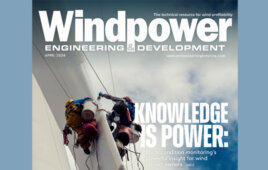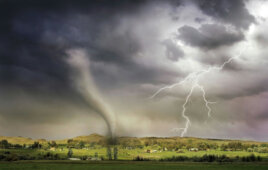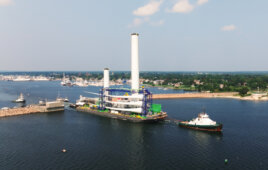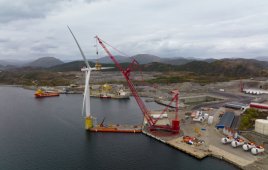This article is the second in a two-part series in which a Failure Mode and Effects Analysis shows how alternating torque damages more than gearboxes. The first article set the stage for how the FMEA would be conducted while this part presents further considerations and results.
Scott Eatherton • President • Wind Driven LLC, scott.eatherton@icloud.com
Emil Moroz • President • EM Energy LLC, emoroz@att.net
Dustin Sadler • Principal Engineer • AeroTorque Corp
Dave Heidenreich, P.E. • Founder and Retired Chief Engineer of PT Tech, Inc.
 In Part I of this series, the authors described the hazards of torque reversals and hard stops, what causes them, and the damage they inflict on wind-turbine gearboxes and other components in a drivetrain. Part 1 is online here: tinyurl.com/aerotorquepart1
In Part I of this series, the authors described the hazards of torque reversals and hard stops, what causes them, and the damage they inflict on wind-turbine gearboxes and other components in a drivetrain. Part 1 is online here: tinyurl.com/aerotorquepart1
The FMEA divides the gear and bearing failure sequence into three distinct stages, and examines the contribution of transient torsional events (TTEs) to each failure stage: initiation, propagation and failure. This section begins with how cracks propagate.
Propagation
Once a crack has been initiated, propagation can begin, driven by cyclic loading, one cause of which is transient torsional events. Fatigue, hence crack growth, is the dominant failure mode in wind-turbine gearboxes. The crack may have been initiated by fatigue, a flaw, or from other pre-existing damage such as debris denting [9] or scuffing [6]. TTEs are strongly linked to fatigue failure modes in standards and failure analysis texts. TTEs accelerate crack growth because it is a function of loading [7]. Crack-growth rates tend to increase over time and the remaining material available to support loads becomes diminished, increasing the stress levels in the remaining material.
Steels that lack fracture toughness have lower fatigue lives than tougher materials. Through-hardened bearings, widely used in turbine gearboxes, have low-fracture toughness, which increases the risk of fatigue failure. Without propagation, initiation will not cause failure, so reducing loading will slow and sometimes stop propagation, thereby extending gearbox life.
Failure
This is the third and final stage in the sequence (initiation, propagation, and failure). A clear definition of failure is required for an accurate FMEA. In this analysis, a gearbox or gearbox component is said to have failed when it meets one or more of the following conditions:
1. Fracture has occurred on one or more parts. Common examples are inner rings with through-cracks and broken-off gear teeth.
2. The wind turbine cannot operate until the gearbox has been repaired or replaced.
3. Functional failures. For example, the turbine must be de-rated to operate with a particular gearbox condition, such as overheating or high gearbox vibration at rated power. In the FMEA, functional failure means the asset operates but does not function at a level of performance acceptable to the owner or user [14].
4. The severity of a failure mode is rated as high or severe in a standard or standards-based failure analysis reference.
5. Component failure means repairs can occur up-tower.
6. Gearbox failure means removal of the gearbox from the tower for repair or rebuild.
7. Catastrophic failure means the gearbox cannot economically undergo repairs or a rebuild.
The through-hardened bearings have low crack resistance [7], so suppressing TTEs should extend useful bearing life and reduce the risk of axial cracking. Cyclical loading drives fatigue, but the relationship is not linear. Halving peak-to-peak amplitude of drivetrain torque transients reduces their fatigue loading by about 75% [17, 19], so it is worth pursuing the life-extending potential of RTD devices.
Fatigue is the dominant failure mode in gearboxes linked to TTEs. Other modes include scuffing and plastic deformation. Fatigue exploits a wide variety of flaws, defects, and prior damage to initiate failure, which is the first of three distinct stages of failure. Initiation is followed by propagation and, finally, failure. Initiation takes the longest of the three stages, propagation is more rapid, and final failure can occur in an instant. The length of time in the initiation and growth stages of fatigue failure modes — ranging from gear tooth bending fatigue to the Hertzian fatigue of bearing elements — is influenced by heavy cyclical loading such as that resulting from TTEs. Analysis of gearbox failure-mode causes and effects suggest that suppressing TTEs has a high potential to prolong the initiation and propagation stages of failure in new, in-service, and previously damaged drivetrains.
Evaluating the impact of TTE on non-gearbox drive components
The dynamics of a wind turbine and the consequences of uncontrolled torque reversals on a drivetrain have the potential to create problems on the drive system beyond the gearbox. Some problems may have materialized within the past 10 years of wind-turbine deployments, while others may still exist that can cause failure before the target design life.
To address this topic, the authors reviewed literature along with a sampling of loads documents. A dynamic loads model (FAST) was run for a sub-MW turbine, some load time histories were reviewed, and best judgment was used to draw together initial suggestions to determine which components might be impacted by TTEs. A summary of components likely to have fatigue lives enhanced by use of an RTD device was developed, but in most cases the data was not sufficient for consensus, especially in comparison with other likely causes of failure modes. So, it was decided to leave the benefits as To Be Determined (TBD).
A more complete way of quantifying the benefit is a combination of instrumented wind turbines and use of the latest system models. Also, different configurations of turbines, with different tower heights, rotor diameters, and control strategies may have different design drivers. The trend toward taller towers and larger rotors will likely make the mitigation of drivetrain TTEs more important than it was in older designs.
Cutting-edge system models, such as SAMCEF and the RomaxWIND drivetrain model embedded within BLADED, capture details of a drivetrain integrated into the dynamic and flexible operating environment of a wind turbine. They’ve helped explain what goes on during harsh braking events [2, 3], but such models are not perfect [3]. Ideally, such models will one day provide a comparison of a more commercially relevant wind turbine under various conditions, with and without the benefit of an RTD device in the drivetrain. This kind of analysis (despite acknowledged shortcomings in terms of ability to capture internal deflections and accurately calculate the effect of transients), would broaden understanding of the benefits beyond the current main shaft torque measurements and adoption of Reverse Torsional Damping.
In the context of this paper, TTEs arise primarily from hard-stop protocols, but have also come from normal shut-down stops and may arise out of rarer fault conditions on a turbine — such as when one of the blades gets stuck between fine pitch and full feather in stormy weather, or even from rare wind-driven turbulence events. Hard stops are usually initiated when a turbine is at high risk, say during an over-speed initiated by a loss of generator load when the controller is not available or is being bypassed for some reason.
Typically, these hard stops come from a rapid pitch of blades to feather or stall with a simultaneous caliper-brake application. The severity of such an event is closely related to the operating point of the turbine. Worst-case loads normally occur near the rated wind speeds, when thrust loads are maximized on a pitch-regulate turbine. In this scenario, the rotor is fully loaded and the tower top is bent downwind by thrust forces. In a hard stop, the tower is suddenly offloaded and typically pulled forward by the negative thrust arising from the pitching blades, before the shaft comes to rest under the influence of the reduced aerodynamic input and the high-speed shaft brake. Real-world recordings have shown the worst torsional loads in the drive system tend to occur during hard stops in high gusty winds, close to cutout speed.
The analysis suggest the following components benefit from lower torque and stresses transmitted through a drivetrain equipped with and RTD:
Rotor blades and related connections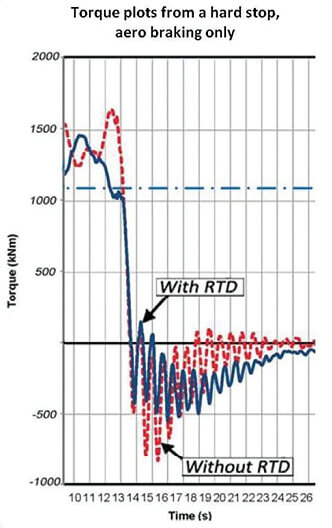
An RTD device has demonstrated, through torque measurements on the low-speed shaft, to reduce shaft torsional oscillations during shutdowns.
Because these torsional oscillations are attributed to the drivetrain vibration, with significant participation of the blades, it is concluded that the blades will benefit from additional damping. When the shutdown sequence begins, blades are roughly “flat” to the wind and the edge-wise direction of a blade should benefit most. But as the blades pitch, the reduction in vibrations will move toward a reduction in flap-wise bending. Along with blades, their connection to the hub will likely have a positive effect because the joint probably has a low-design margin related to fatigue.
Main shaft to rotor hub bolts
While it is not known if TTEs have a significant effect on the bolted connection between the main shaft and the rotor hub, it is thought that large oscillatory motion and resulting forces could potentially contribute to bolt loosening. In this case, mitigation of TTEs could be beneficial.
Main-shaft bearings
This FMEA assumes a three-point gearbox suspension with a locating spherical roller main bearing that supports all the rotor’s axial thrust and most of its radial force. Hence, it is intended to take the bulk of the rotor’s non-rotational loads so they do not transmit to the gearbox. The degree to which the main bearing protects a gearbox is a function of the drivetrain configuration: whether a three or four-point suspension, or other configuration. Regardless of configuration, it is believed the main bearing must react significantly to oscillatory side forces during a stop, especially a hard stop. As such, the main bearing will benefit from an RTD device that extracts energy from the torsional vibration and reduces the amplitude of these oscillations. In addition to a reduction in high-cycle fatigue of the bearing elements and fretting of the bearing to bedplate interface, a significant reduction is expected in sudden bearing skewing resulting from torque reversals.
Load reversals are known to damage the drive-system bearings. Such reversals are often more damaging when bearings are not rotating. The potential for surface damage is further exacerbated when stationary bearings are subject to simultaneous axial forces and rapid axial motion. Large conventional spherical-roller bearings have a high internal clearance in the axial direction. This limits axial motion and allows a line-contact impact between rollers and raceways. This can happen at the end of an aero and caliper-braking hard stop, when the main bearing is restraining axial load reversals from the high fore and aft oscillations of the tower, and simultaneously with radial-load reversals from the side-to-side tower oscillations.
High-speed shaft coupling
The high-speed shaft coupling accommodates small deflections and misalignments. It should withstand bedplate deflections and relative movement between the generator and gearbox arising from a hard stop, and still live with rotational fatigue. Nevertheless, significant misalignment will shorten coupling life, so it is postulated that a reduction in amplitude of large oscillations will have a positive benefit on fatigue life. Some turbines have documented issues of premature coupling failures [15].
Generator bearings and rotor windings
Bearings at both ends of a generator “experience high oscillations when the brake is applied due to the flexibility in the coupling and the proximity of the bearings to the brake disc.” [3] An RTD device between the brake disk and the generator is expected to remove energy from the worst of these oscillations, inferred from the time histories of the 1.6MW and 1.65-MW turbines presented in Part I. It’s also hypothesized that the reduction in oscillatory forces acting on the elements of the generator rotor will help extend its life.
Electronics and electrical systems
Thermal issues are considered the primary cause of premature failures in most electronic and electrical components. However, high vibration can also shorten life of components by loosening connections and breaking down insulation. Insulation deterioration can result in thermal failure. It’s suspected that an RTD device’s demonstrated ability to reduce more than 75% of the high-torsional oscillating energy in the drive system during hard stops may reduce the vibration excited in turbine substructures that support electrical components. A practical way to learn if this could result in financial benefit is to track failure rates and costs of turbines equipped with an RTD device, as compared to one without an RTD device.
Bedplate
“Large transient loads, such as those produced during an emergency stop, will apply large loads to the bedplate (mainly through the low-speed bearing supports and gearbox mountings) causing deflections that effect the whole drivetrain. Unpublished finite-element analysis (FEA) models indicated that these can cause significant deflection of the bedplate and nacelle structure, resulting in potential misalignment. This in turn can cause loads on the drivetrain bearings to significantly increase, most likely resulting in unacceptable damage accumulation” [3]. These deflections are more likely to impact welded bedplates that have a history of suffering from cracking of material, and may not have as much effect on more common cast designs.
Tower repairs, tower bolted connections, and anchor bolts
A review of design load time histories show that oscillatory loads, derived from gearbox torque arm reaction forces during stops, enter the tower and are visible all the way down to the foundation. These reactions manifest themselves, primarily, as rolling moments of higher frequency than the tower’s first natural frequency. The simulations available to support this paper show that occurrences of these oscillations correspond to the oscillation of the blades and drivetrain. Field measurements, however, show that in addition to the oscillations associated with the initiation of the shutdown procedure, torsional reversals occur as the brake activates and rotation stops. These oscillations are also reflected throughout the tower.
Given that the “rolling” oscillations entering the tower correspond to torsional variations on the low-speed shaft, which can be damped by an RTD device, it is clear that the tower system will also benefit from this damping. While the tower shell and flanges can likely accommodate higher loads than may arise from these oscillations, it is unclear whether or not there’s a meaningful impact on the bolted connections from transverse oscillations or resulting deflections. Dynamic modeling, with and without an RTD device, can help quantify the impact on overall tower fatigue and ultimate loads, but won’t get into the details of the bolted joints. FEA may help in analyzing potential benefits, but it is simpler to monitor bolt checks throughout towers (with and without an RTD device) to see if this results in a reduction of loosened bolts.
Results from the FMEA
Results of the FMEA show significant minimum potential savings for the gearbox when the turbine is installed with an RTD device. The gearbox is the focus of substantial industry research because there are many records of failures along with good understanding and documentation of the effects of torsion vibrations, TTEs, and overloads on bearings, gears, and gearboxes systems. The focus recently has been on the chronic axial cracking of high-speed inner rings and its relationship to loading and other factors.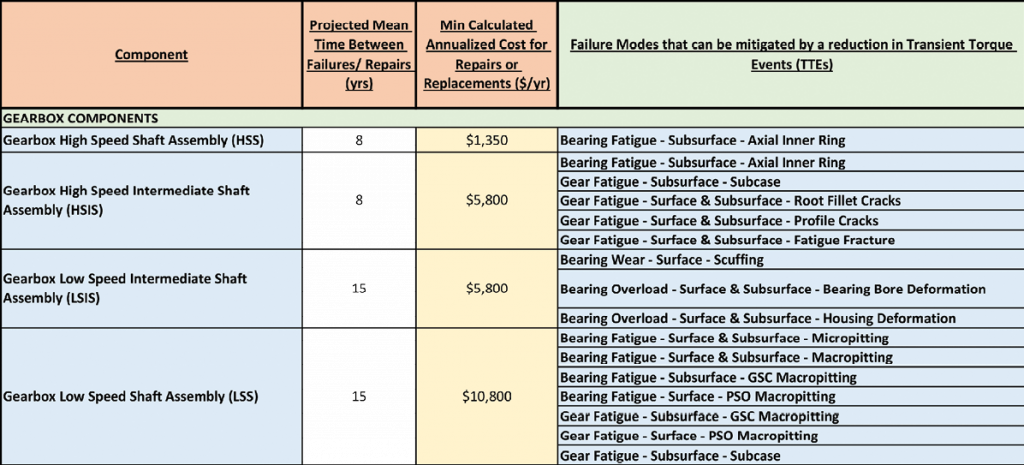
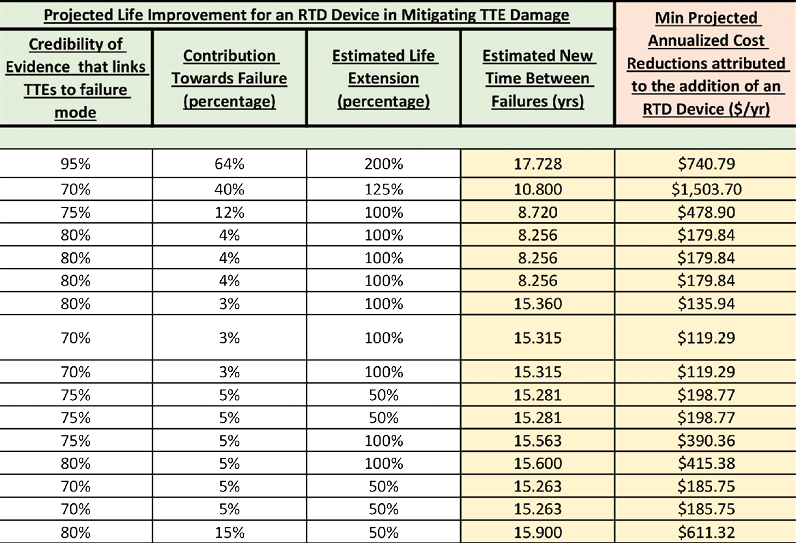
The stacked tables (properly viewed side by side) are a small part of the entire FMEA spreadsheet but they show the detail to which drivetrain components were considered in the analysis. The complete spreadsheet is available at www.aerotorque.com.
The FMEA shows potential value for installing an RTD device. For instance, the high-speed assembly shows bearing axial inner ring subsurface fatigue, which includes axial cracking. The same failure mode shows up in the intermediate high-speed assembly, along with an additional four modes of gear failure. The low-speed intermediate assembly shows a few areas for potential moderate improvement related to bearing wear and overload modes. Finally, the low-speed assembly shows several significant potential savings through a combination of bearing and gear-fatigue failure mitigation opportunities. This is driven by the high cost of replacement or repair for these components and assembly systems.
There is one additional failure mode outside the gearbox identified by the FMEA. Bearing skewing and its resulting damage in the main-shaft bearings is shown to have a significant minimum potential cost savings. Due to insufficient information to show that an RTD device can have a significant impact on other non-gearbox components, there is a challenge in quantifying contribution and life impact in the absence of a dedicated set of loads, with and without an RTD device. Therefore, the potential benefit has been labeled as TBD. More work or reference material or both are required to bring the non-gearbox contribution to the same level as the gearboxes.
The table A few cost reductions provides a summary of the costs from significant failure modes by gearbox component. The minimum cost does not include crane costs, lost production, or labor reassignment costs. Furthermore, the values in the right-hand column show the most significant cost savings attributed to the mitigation of damage to a wind-turbine gearbox, using only a few of its major failure modes.
For the entire system, the table identifies which components gain most from the cost reductions benefit. The table also summarizes the failure modes highlighted in the table Simplified FMEA, non-critical modes removed. The greatest identified savings of installing an RTD device onto a wind turbine is demonstrated in the gearbox, so this paper focuses on that component, rather than on non-gearbox components. This data indicates that an RTD device would provide a significant minimum cost savings to the high and low-speed intermediate shaft assemblies, with some additional savings attributed to the high and low-speed shaft assemblies.
The results of the FMEA indicate that an RTD device may produce significant savings to justify installation after evaluating the gearbox alone. Combine that with potential savings from the main-shaft bearings and the RTD value increases further. Once a site has a statistically significant quantity of installed RTD devices it could present further value by tracking costs associated with non-gearbox components identified with TBD. Taking actual failure and cost data from a wind-turbine site further supports the FMEA as a valuable tool, and could show greater potential savings, depending on the frequency and type of failures at that site.
The FMEA model predicts that installing an RTD device could reduce annual gearbox costs by a minimum of 37%, not including crane costs, lost production, or labor reassignment costs. The FMEA further predicts that an annualized gearbox lifecycle cost of $23,750 could reduce to $8,800 with an RTD device installed. This represents a conservative one to two-year payback. Including the other drivetrain components and major turbine components, the FMEA forecasts an annualized lifecycle total turbine cost of over $47,000, but the potential savings from an RTD device is not fully estimated because of insufficient information on the effect of TTEs on most of these systems.
This analysis has some shortcomings due to the method for simplifying the failure data and frequency. Some scenarios, such as a complete gearbox replacement or rebuild, would affect the uninterrupted linear nature of the projected mean time between failures. This could “reset” the timing of the failure modes’ life with the installation of new bearings and gears. So, following a replacement or rebuild, the failure modes would be delayed, as compared to the linear method that this FMEA uses.
Regardless of the shortcomings, this simplified FMEA uses conservative assumptions to calculate costs and projected savings from the installation of an RTD device. It justifies the installation immediately after or during the repair or replacement of any major drivetrain component to maximize the extension of life by preventing damage.
Final thoughts
All wind turbines are subject to a variety of hard stops. Whether they use aero-braking only or combine aero-braking with caliper braking, these transient events can often produce undesirable torque reversals and significant torsional oscillations. RTD devices have proven their ability to reduce these kinds of undesirable transient loads during stops.
A review of the literature provides evidence that, in a gearbox, many premature failures in bearings, gears, and shafts can be attributed to TTEs. For non-gearbox elements, details of the impact of TTEs were not so readily available, but there is evidence and logical arguments can be made to support a conclusion that many of these components are adversely affected by TTEs.
The FMEA presented has made a conservatively framed case that the introduction of an RTD device into a wind-turbine drivetrain can mitigate risk and reduce the cost of operation, and shows a relatively brief one to two-year payback on gearbox savings alone. As more RTD devices are installed and accumulate more run time, the effects on failure modes, reliability, and cost saving benefits are expected to become clearer and estimates of benefits to non-gearbox components will be clarified.
Evidence collected during the deployment and monitoring of RTD devices is expected to help refine system models and provide designers with better tools to optimize future wind-turbine designs.
Recommendations
The data reviewed in this paper encourages site-wise retrofits, while the value per turbine might be even higher for those unit with an above-average number of hard or emergency stops per year. For many wind farms, the conservative one to two-year payback, in the gearbox cost savings alone, can justify fleet-wide installation of RTD devices. Other wind-farm owners may prefer retrofitting a statistically significant number of turbines and tracking the performance and reliability of those turbines, compared with a control set of other turbines. At the very least, wind-farm owners experiencing chronic problems with gearboxes or other major turbine components should look at installing an RTD device when those components are replaced or repaired.
For those wishing to do partial wind-farm retrofits, there are many early indicators that can demonstrate the ability of an RTD device to reduce loads and extend life. For turbine models that have not already demonstrated the load reduction capability of an RTD device, it’s recommended to record side-by-side torsional load graphs during hard stops, and on turbines with and without an RTD device. Examples of these graphs are presented in this article. Within a couple weeks, the recordings can provide valuable evidence of reductions in some of the worst turbine transient load events. However, the strongest benefit is a reduction in O&M costs and unscheduled downtime, with an associated increase in energy production within one year.
Appendix
The appendix for this article provides extensive background information on the subjects discussed in the article but it is too long to reproduce here. However, it will appear in its complete form online here: www.tinyurl.com/aerotorquepart1 Briefly, the appendix heads include:
• How an RTD device works (through frictional slippage and damping)
• Torsional behavior at the generator with an RTD device. It provides more than a 50% reduction in torsional oscillations and reversals at the generator shaft.
• Real world concerns, such as flaws in blades that surface with TTEs.
• Gearbox assembly definitions clearly identify components on each shaft assembly.
• FMEA header definitions provides more supporting detail on each, and
• Wind turbine design standards, such as IEC 61400-1,and its four editions
For further reading
2. Heege, A, et al, Fatigue Load Computation of Wind Turbine Gearboxes by Coupled Structural, Mechanism and Aerodynamic Analysis, DEWI Magazine No. 28, February 2006.
3. Scott, K., et al, Effects of Extreme and Transient Loads on Wind Turbine Drive Trains, 50th AIAA Aerospace Sciences Meeting, Nashville, TN, Jan 10-12, 2012.
6 Baker, P. and Eatherton, S., Adhesive and abrasive Wear of Roller Ends and Ribs in Wind Turbine Gearbox Bearings, Gearbox Reliability Collaborative, 2014.
7. Errichello, R. L., Gear & Bearing Failure Analysis, Geartech, 2011.
9. Errichello, R. L., Hewette, C., Eckert, R., Point-Surface-Origin, PSO, Macropitting Caused by Geometric Stress Concentration, American Gear Manufacturers Association, 2010.
14. Moubray, John, Reliability-centered Maintenance, second edition, Industrial Press, 1997.
15. Sheng, Shuangwen, Report on Wind Turbine Subsystem Reliability – A survey of Various Databases, National Renewable Energy Laboratory, 2013.
17. Jackson, Kevin. NREL Technology Exchange Workshop, October 1993.
18. Errichello, Budny and Eckert, Investigations of Bearing Failures Associated with White Etching Areas (irWEAs) in Wind Turbine Gearboxes, STLE, Detroit, May 2013.
19. Meyer, Haydn, Schuller et al, Very High Cycle Fatigue Properties of Bainitic High Carbon-Chromium Steel, International Journal of Fatigue, September 2008.
Reach the authors at: scott.eatherton@icloud.com, emoroz@att.net, and info@aerotorque.com
Filed Under: Featured, O&M

